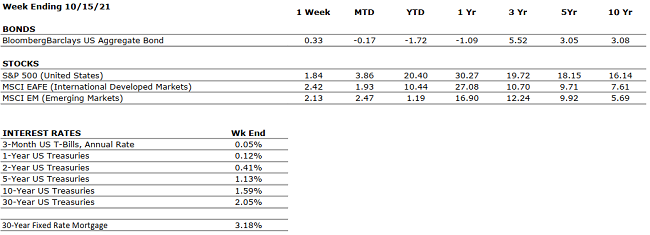THE NUMBERS
 Sources: Index Returns: Morningstar Workstation. Past performance is no guarantee of future results. Indices are unmanaged and cannot be invested into directly. Three, five and ten year returns are annualized. Interest Rates: Federal Reserve, Mortgage Bankers Association.
Sources: Index Returns: Morningstar Workstation. Past performance is no guarantee of future results. Indices are unmanaged and cannot be invested into directly. Three, five and ten year returns are annualized. Interest Rates: Federal Reserve, Mortgage Bankers Association.
MARKET HEAT MAP
The health of the economy is a key driver of long-term returns in the stock market. Below, we assess the key economic conditions that we believe are of particular importance to investors.
|
US ECONOMY |
||
|
CONSUMER HEALTH |
POSITIVE |
September retail sales surprised to the upside, increasing 0.7% month-over-month (m/m) and 13.9% year-over-year (y/y). Economists expected September’s retail sales to decline slightly m/m. |
|
CORPORATE EARNINGS |
POSITIVE |
S&P 500 Q3 earnings season is just kicking off. With <10% of companies having reported, sales and earnings are up 15% and 29%, respectively. However, company commentary suggests that the supply chain will be problematic in the coming quarters. |
|
EMPLOYMENT |
POSITIVE |
The unemployment rate is down to 5.2%. In August, new job creation was disappointing, but jobless claims were as low as they have been since March 2020. |
|
INFLATION |
NEUTRAL |
CPI rose 5.4% year-over-year in September, driven by the global supply chain backlog. |
|
FISCAL POLICY |
POSITIVE |
A bill to lift the U.S. debt ceiling by $480 billion – which should provide enough headroom for government operations until December 3 – was passed this week. |
|
MONETARY POLICY |
POSITIVE |
In recent communications, the Fed has indicated bond tapering may begin by the end of 2021 while rate hikes could commence by the end of 2022. Nonetheless, monetary policy remains relatively accommodative with rates at historical lows. |
|
GLOBAL CONSIDERATIONS |
||
|
GEOPOLITICAL RISKS |
NEUTRAL |
Although the Taliban’s control in Afghanistan is concerning, it is unlikely to have a meaningful economic impact. |
|
ECONOMIC RISKS |
NEUTRAL |
Supply chain disruptions caused by the Delta variant are hampering the economy, however, demand remains very strong. While supply bottlenecks will likely arise over time as new strains surface, the hold-ups appear primarily transitory and should ease progressively in a post-COVID world. |
The “Heat Map” is a subjective analysis based upon metrics that VNFA’s investment committee believes are important to financial markets and the economy. The “Heat Map” is designed for informational purposes only and is not intended for use as a basis for investment decisions.
